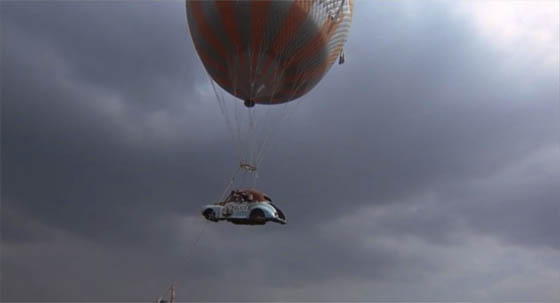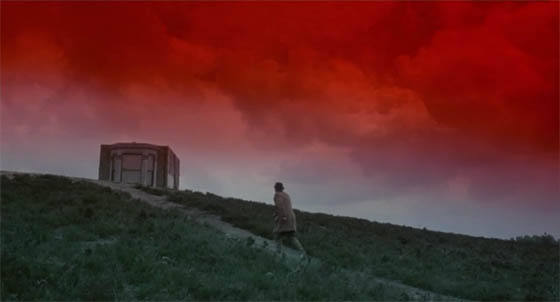 It’s all a matter of tone. The Bed Sitting Room (1969) could be the bleakest nuclear apocalypse movie ever made. Its themes, characters, and incidents could be unbearably disturbing; and in many ways they still are. But the ideas are pressed through a filter, which reduces our story to a broad satire that, at times, resembles a dry-as-hell BBC sketch comedy series, and at other times a Looney Tunes cartoon. The Bed Sitting Room is nonetheless haunting, because although it’s a comedy, we know what’s really at stake. Which is everything: our society, our children, our world – us. What I am saying is that you will probably not burst into tears when the end credits roll. In fact, the minds behind this film have actively worked to prevent that. The poster should have boasted that ambiguous guarantee: “You’ll laugh until your sides hurt, which means there is a very good chance that you will not succumb to existential despair. Look! Look at the funny parrot and watch Dudley Moore transform into a cute little dog! We will all die in the end.”
It’s all a matter of tone. The Bed Sitting Room (1969) could be the bleakest nuclear apocalypse movie ever made. Its themes, characters, and incidents could be unbearably disturbing; and in many ways they still are. But the ideas are pressed through a filter, which reduces our story to a broad satire that, at times, resembles a dry-as-hell BBC sketch comedy series, and at other times a Looney Tunes cartoon. The Bed Sitting Room is nonetheless haunting, because although it’s a comedy, we know what’s really at stake. Which is everything: our society, our children, our world – us. What I am saying is that you will probably not burst into tears when the end credits roll. In fact, the minds behind this film have actively worked to prevent that. The poster should have boasted that ambiguous guarantee: “You’ll laugh until your sides hurt, which means there is a very good chance that you will not succumb to existential despair. Look! Look at the funny parrot and watch Dudley Moore transform into a cute little dog! We will all die in the end.”
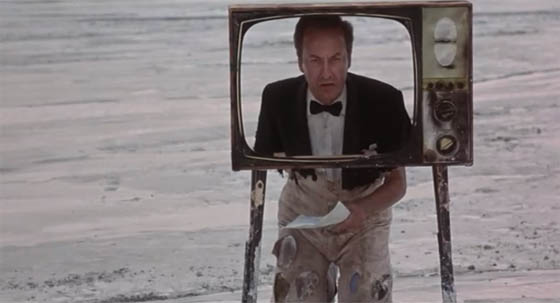
Frank Thornton as "The BBC" delivers the news to an audience of one.
Though it’s ostensibly about the aftermath of a nuclear World War Three, the film could only have been made by those who lived through World War Two: the blacker-than-black humor feels earned. The Bed Sitting Room is based on a play by Spike Milligan and John Antrobus, which debuted as a one-act play in 1962, and was broadened into a full-length work in 1963. Antrobus was a noted English playwright and Army vet; Milligan, who had served in WWII, was a renowned radio and TV personality in England, and though he wasn’t particularly well known in the States, his manic and surrealistic radio program The Goon Show ran for an impressive nine years, helped kickstart the career of Peter Sellers, and influenced just about every British comedy group in its wake. By 1969 he was launching Q5, an experimental, stream-of-consciousness comedy program which debuted mere months before Monty Python’s Flying Circus and made that team (Spike Milligan fans all) realize they’d now have to work harder to make their own series cutting-edge. Meanwhile, Richard Lester, the very cutting-edge director of the Beatles films A Hard Day’s Night (1964) and Help! (1965), as well as The Knack…and How to Get It (1965), How I Won the War (1967), and Petulia (1968), had decided to take on Milligan and Antrobus’ play The Bedsitting Room – which had recently been revived on the stage, to great success – as a feature film boasting a cast loaded with famed British character actors, many of them veterans of either The Goon Show or Lester’s own filmography. (The opening credits list them “in order of height.”) Lester shot the film in the junkyards and polluted lakes that he found off England’s beaten paths, to represent a devastated London. Perhaps unwisely, the film was released with a poster proclaiming “We’ve Got a Bomb on Our Hands.” This was a self-fulfilling prophecy.
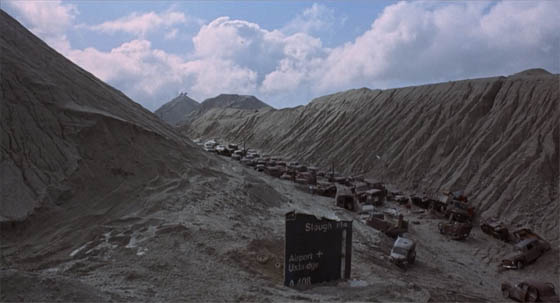
Traffic is at a permanent standstill after the Bomb.
Actually, “bomb” is taboo in The Bed Sitting Room; the characters approach the word and then stumble their way past it, without ever quite speaking it. It’s as though the word has been wiped from their memory, despite the fact that the decimated landscape in which they putter about is all the evidence they need of what came before. As the film begins, the characters are scattered and frightened, though a few have begun to reconcile themselves into roles, to keep society functioning, or just to seize power where they can. Peter Cook and Dudley Moore (inseparable) are the Police, floating in the bottomless shell of a car which is tethered to a hot-air balloon; Cook barks orders at the denizens of the wasteland through a melted megaphone (it looks like one of Dali’s clocks). He prods that chipper fellow running the electric generator by bicycle. He asks that everyone “keep moving, keep moving,” to avoid the effects of atomic mutation, which manifests itself through bizarre transformations. A family peers out the windows of a train that perpetually runs in a circle through the empty stations of the Underground. A delusional nurse (Marty Feldman) watches everyone through his binoculars before inserting chaos into their lives. A raving lunatic in a bomb shelter (Harry Secombe) studies tangled strips of film for evidence of what might be poisoning the countryside. A doctor, Bules Martin (Michael Horton), introduced sitting on an enormous pile of black shoes (Doc Martens?) searching for a pair that fits, diagnoses the pompous Lord Fortnum (Sir Ralph Richardson) as transforming slowly into a bed-sitting room. This explains why Fortnum feels a strange compulsion to pave cement onto his cheek, and appears to be spontaneously producing bricks. In the opening scenes, Lester intercuts between his scattered characters with deliberate confusion; gradually they will come together, just as society begins to rebuild itself into the same depressingly ill-conceived structure.
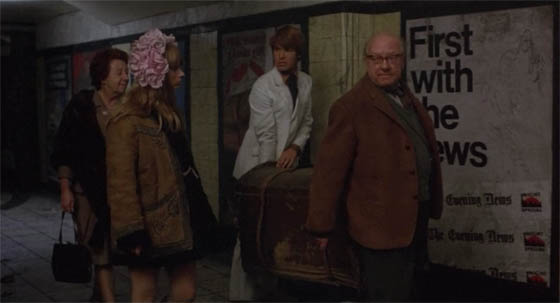
A family dares to escape the safety of the London Underground: Mona Washbourne, Rita Tushingham, Richard Wardwick, Arthur Lowe
What little linear plot we receive involves that family in the train, which finally decides to leave the safety of their surroundings when they realize that their daughter Penelope (Rita Tushingham) isn’t “chubby,” as they thought, but actually eighteen-months pregnant by a boy, Allan (Richard Wardwick), riding the train behind them. They need to go topside to find a nurse, taking with them a chest, and, unwittingly, a stowaway riding inside it (Father is embarrassed that the chest appears to be growing hair from under its lid, so he keeps it neatly trimmed). They’re not long into their travels when they meet Nurse Arthur (Feldman), who hands them a death certificate for Mother (Mona Washbourne). “The way I’d like you to look at it sir is like this. You may have lost a wife – but you’ve gained a certificate.” Mona is distraught to learn that she’s dead, and the Nurse takes her away, where she falls into the shelter occupied by Harry Secombe, obsessed with the memory of his dead spouse. “Will you do for me what my first wife did?” he asks her breathlessly, cornering her against the wall. “Well, as long as we get it over quickly,” she says reluctantly. He then hands her some teacups and a saucer, which she throws at him while he screams, “Now, now, be reasonable, Mildred! She was nothing but a common secretary! I love you!” When this play has reached its conclusion, he slumps against a bookshelf in exhaustion, and then, recovering his senses, screams at her, “Get out, you slut!”
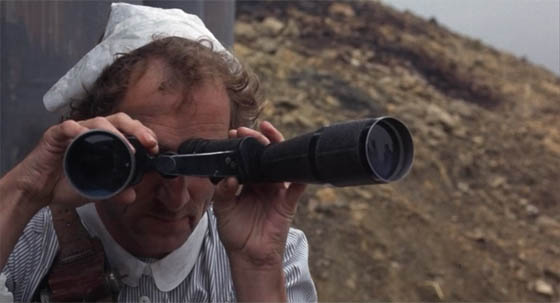
Marty Feldman as Nurse Arthur
The film is rich with absurdist dialogue. Dr. Bules Martin treats Lord Fortnum as follows:
“Take, um, six of these pills, one every half-mile.”
“Oh, but I can’t do that, I only live a mile away. This is Hyde Park, isn’t it?”
“Yes, then you’ll have to move further out, I’m afraid.”
“I tell you what, I’ll take the long road home.”
This is shortly followed by Spike Milligan, as “Mate” (a purposeless character who travels from scene to scene), knocking at the door to this doctor’s office without walls, and delivering a telegram for Martin, which is a pie in the face. Eventually our crumbling family unit meets the doctor, who asks to court Penelope. Father is so impressed by the doctor’s credentials that he immediately agrees to a union between the two, despite the fact that she’s in love with Allan, and about to give birth. She weds the doctor in a surrealistic ceremony on the shore of the sea (the Vicar swims over before conducting the proceedings), but it’s Allan who takes her to the mattress-free wedding bed. The doctor quickly becomes resigned to this. When they find a honeymoon suite, it’s the bed-sitting room, formerly Lord Fortnum, who’s finding his new state disagreeable. I should mention that the wardrobe in the room is Penelope’s mother, who, despite the transformation, objects strongly when people open her drawers. And Father, not immune to the effects of fallout, is beginning to turn into a parrot.
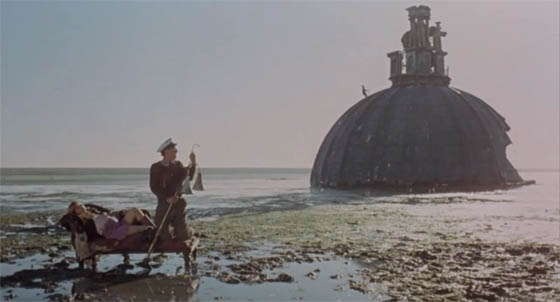
Doctor Bules Martin (Michael Hordern) rows Penelope (Rita Tushingham) to the chapel.
None of this makes any sense, except that it kind of does. The Bed Sitting Room follows an internal logic which keeps every non sequitur connected. There’s a cumulative energy, which means that in the early stretches the film feels randomly surreal and somewhat lethargic, but as the viewer begins to comprehend the rules of this fictional world, it achieves a narrative coherency as well as an eerie power. It’s natural to compare the script to Waiting for Godot, which has a similar progression, as well as Eugène Ionesco’s Rhinoceros. But you could also cite Lewis Carroll as an influence (Nurse Arthur is the Mad Hatter and the March Hare rolled into one, and Penelope is our sympathetic Alice). The non-stop absurdities are thematically organic; in the age of the nuclear bomb, when mankind has the unprecedented ability to wipe itself out of existence, The Bed Sitting Room‘s insanity feels like an appropriate response. Despair hangs heavily over every scene, and becomes almost unbearable in the finale, when Penelope finds herself the only character capable of weeping at the tragedy of their circumstances, and Sergeant Dudley Moore finally gets to swing that wrecking ball he’s been wielding, threateningly, for much of the film. But the dialogue continues, relentlessly, to be witty and wise, and the final image of the film is genuinely hilarious (and very Pythonesque, before that word was added to the OED). It’s a cathartic little film, and would make a fascinating double-feature with Godard’s Week-End (1967) if anyone could bear it. Highly recommended for anyone who likes their satire cynical and confidently strange.
